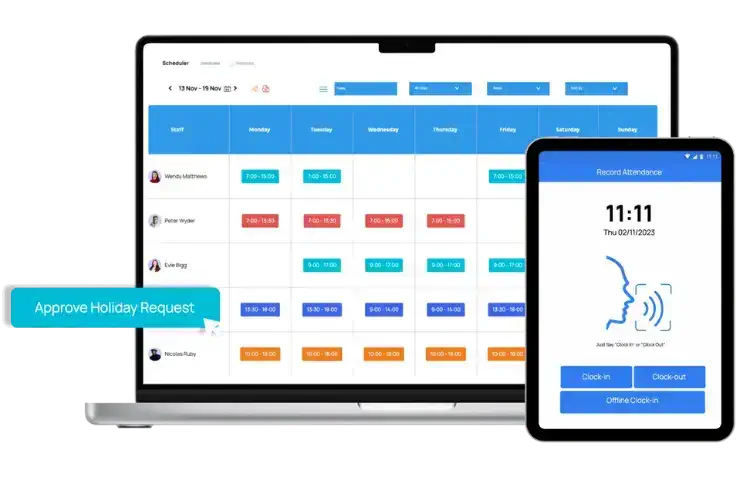How to Choose the Right Attendance Management Software

Selecting the right attendance management system is a crucial decision for any business aiming to streamline its operations and improve productivity. With numerous options available, it can be overwhelming to decide which software best fits your needs. Whether you want to automate time tracking, reduce errors, or ensure compliance with labour laws, choosing a solution that aligns with your organisation’s goals is key.
Today, we will guide you through essential tips that will help you make the right choice for your business.
Understanding Your Needs
Before diving into the selection process, it’s essential to have a clear understanding of your organisation’s specific needs. This will make it easier to identify the best solution for your business.
Here are a few important factors to consider:
- Define your objectives: What do you want to achieve with the attendance management system? Are you looking to automate manual processes, reduce human errors, improve compliance with labour laws, or enhance the efficiency of tracking employee attendance? Knowing your primary goals will narrow down your options.
- Workforce requirements: Consider the size and nature of your workforce. Do you have remote workers, employees with flexible working hours, or teams that work across different shifts? The software you choose should accommodate your workforce’s unique characteristics, ensuring easy tracking and management for all types of workers.
- Integration capabilities: Ensure the system can integrate with your existing platforms, such as payroll and HR software. Seamless integration is important for reducing duplication of tasks and ensuring smooth data flow between different systems.
- Compliance and regulations: Depending on your industry, you may need to comply with specific labour laws or regulations regarding employee attendance. Make sure the software you choose is designed to handle compliance requirements, such as managing overtime, leave policies, or break periods.
Engaging with key stakeholders such as HR managers, IT staff, and team leaders during this phase can provide valuable input into the decision-making process. By clearly defining your needs and gathering input from the right people, you can create a list of must-have features that will guide you when evaluating different systems.
Evaluating Features and Functionalities
Once you have a clear understanding of your needs, it’s time to focus on the features and functionalities that will add the most value to your business. While different systems may offer a variety of features, the following key functionalities are particularly important for an attendance management system:
- Automated time tracking: Automating time tracking eliminates the need for manual input, which can be prone to errors. Look for systems that offer real-time tracking of employee attendance, ensuring accurate and up-to-date records.
- Biometric integration: For businesses with multiple locations or remote employees, biometric features such as fingerprint scanning or facial recognition can improve security and accuracy. These systems ensure that the correct person is clocking in and out, reducing the risk of “buddy punching” (when one employee clocks in for another).
- Mobile accessibility: A mobile-friendly solution is important if your workforce is spread across different locations or if employees work remotely. Mobile apps can allow employees to check in and out, view their attendance records, or request time off, all from their smartphones.
- Customisation and flexibility: Every business has unique policies and workflows. Look for software that allows you to customise attendance rules, schedules, and reporting to match your specific needs. This ensures the system can adapt to your business rather than forcing you to adapt to the system.
- Reporting and analytics: Data-driven decision-making is essential for managing attendance effectively. A good system will provide detailed reports on absenteeism, overtime, and attendance trends, giving you valuable insights into your workforce’s behaviour.
By focusing on these core features, you can select a solution that simplifies attendance management, reduces errors, and improves overall efficiency.
Budget Considerations
Budget is always a key factor when choosing software. It’s important to ensure that the attendance management system you select not only meets your needs but also fits within your financial plan.
Here are a few key budget considerations:
- Initial costs: These include software purchase or subscription fees. Some systems are available on a subscription basis, while others may involve a one-time purchase. Understand what pricing model works best for your business.
- Ongoing expenses: Be mindful of additional costs, such as hardware requirements (if you’re implementing biometric systems), training for staff, and any future customisation or integration needs.
- Return on investment (ROI): Consider the long-term value the system will provide. Will it save time by automating manual tasks? Will it reduce errors that could cost the business money in the long run? A good system should deliver tangible ROI by improving efficiency and reducing operational costs.
- Scalability: As your business grows, the software should be able to grow with it without significant additional costs. Look for systems that allow for easy upgrades or the addition of new users at a reasonable price.
A cost-benefit analysis can help you understand the financial impact of your choice. Make sure you are not just looking at the upfront costs but also considering the long-term value the system will provide.
Checking User Reviews and Testimonials
User reviews and testimonials are a valuable resource when selecting an attendance management system. They provide real-world insights into how well the software performs and how it fits into other organisations’ operations.
- Look for reviews from similar companies: Pay attention to feedback from businesses of a similar size or industry as yours. Their experiences will likely be more relevant to your specific needs.
- Analyse patterns in feedback: If you see consistent praise for ease of use or common complaints about poor customer service, these patterns can give you a clearer idea of the software’s strengths and weaknesses.
- Use third-party reviews: While vendor websites often feature positive testimonials, it’s important to look for unbiased opinions. Check third-party review sites to get a balanced view of the software’s performance.
- Engage with existing users: Forums or professional networks can offer opportunities to ask specific questions and get feedback from current users. This can help you address concerns or requirements specific to your business.
By doing thorough research and gathering feedback from multiple sources, you’ll be better equipped to make an informed decision.
Ensuring Scalability
Your attendance management system should be able to scale as your business grows. Consider the following factors to ensure long-term success:
- User capacity: As your workforce expands, the software should be able to handle more users without compromising performance. Ensure the vendor offers scalable licensing options that allow you to add users or upgrade the system as needed.
- Functional expansion: Your business processes may evolve over time. Check if the software can accommodate new attendance policies, integrate with additional tools, or support new compliance requirements as your business grows.
- Data volume: As you collect more attendance data, the system must be capable of handling and storing large amounts of data without slowing down.
By choosing a scalable system, you’ll avoid the need for costly replacements or upgrades as your company expands.
Trial Periods and Demos
Finally, don’t overlook the value of trial periods and demos when evaluating attendance management systems. These give you hands-on experience with the software before making a commitment.
- Request a trial: Most vendors offer a trial period that lets you test the software in real-world scenarios. Make sure the trial is long enough to assess its features thoroughly.
- Involve key stakeholders: During the trial, involve HR managers, IT staff, and team leaders to get feedback on usability, functionality, and integration with current systems.
- Compare multiple demos: Watching vendor-led demos can help you understand the system’s advanced features and how they meet your specific needs.
Using trials and demos to evaluate different options can help you identify the best fit for your business.
Conclusion
In conclusion, choosing the right attendance management software is a vital step in improving your business’s efficiency and productivity. By clearly understanding your organisation’s needs, evaluating key features like automation, reporting, and compliance support, and considering budget and scalability, you can select a system that meets both current and future requirements. Engaging with user reviews and taking advantage of trials and demos will also give you valuable insights into how well the software performs in practice.
Read also: United Kingdom Diabetes Market, Size, Forecast Report 2023-2028









